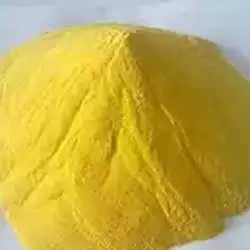IUPAC Name
-
Cas Number
1327-41-9
HS Code
2827.32.00
Formula
[Al2(OH)nCl6-n]m
Appearance
White or Slightly Yellowish Powder
Common Names
Aluminum Chlorohydrate, Polyaluminium Hydroxychloride, Aluminium Chloride Hydroxide
Packaging
25 kg PP woven bag
Polyaluminium Chloride (PAC) is an inorganic polymer coagulant. It is a yellow solid powder that is widely used in water treatments. PAC is better than other aluminum salts such as aluminium chloride, aluminium sulphate, and other various forms of Polyaluminium chlorisulfate and Polyaluminium chloride that they have lower charge than PAC.
Manufacturing Process
These are 2 methods for polyalumunium chloride production or manufacturing process, the Gypsum process, and the Pressure process. The pressure process is widely used in Europe and Latin America. These are the following steps:
1. Mixing the press cake with Hydrochloric acid.
This process needs press cake as a raw material that containd aluminium metal, alumina chloride, alumina tryhidrate, and aluminium sulphate. The press cake mixes with concentrated hydrochloric acid that they are blended in an agitated tank. The press cake contains about 9% (w/w) aluminium and 12% (w/w) sulphate. The cake is solute in hydrochloric acid solution. The temperature of this reactor reach about 150oC and the pressure is high.
2. Mixing the product with aluminium hydroxide
The first process is releasing hydrogen as a side product. It is an explosive and hazardous substance. The industry usually adds the aluminium hydroxide in the second process. The combination of aluminium hydroxide and hydrochloric acid produces aluminium chlorohydrate (ACH). This reaction determines the value of m and n in the Polyalumunium chloride molecules. This reaction happens at 500 kPa and 170oC.
Precipitating the solution
Pressure and temperature of olyalumunium chloride sink into the standard level. Stable PAC needs at least 9 weeks at 30o to precipitate. The presence of water during the process will be evaporated in the reactor that produces steam. Finally, Polyalumunium chloride contains more than 50% Al2O3.
Water Treatment Industry
Polyaluminium chloride is used in the treatment of drinking portable water and wastewater treatment. PAC is well known to be used as a flocculant for wastewater treatment. It can remove impurities such as heavy metal, organic matter, and colloidal particles. PAC has more advantages than other coagulant chemicals. For example, PAC reacts faster due to its high charge, they form bigger flocs so it is easy to filtrate, PAC is efficient to be used over a wide pH range, decreased cleaning frequency of the filters, reducing health problem, and it uses lower dosage than the other chemical coagulant.
Artificial Coal Industry
Polyalumunium chloride is used for separating coal and water with excellent effect.
Oil Refining
Polyalumunium chloride is used for oil and water separation.
Pharmaceuticals Industry
Polyalumunium chloride is widely a raw material for deodorant manufacturing.
Other Applications
Polyaluminium chloride is widely used for setting dyes as a mordant, tanning the leather, fire retardant in textiles, coagulation agent for rubber latex, and in pulp and paper manufacture.
